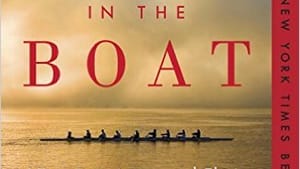Stay in the Loop
BSR publishes on a weekly schedule, with an email newsletter every Wednesday and Thursday morning. There’s no paywall, and subscribing is always free.
The back cover of the paperback edition of Daniel James Brown’s best-seller, The Boys in the Boat, declares it “the improbable... account of how... working-class boys from the American West showed the world at the 1936 Olympics in Berlin what true grit really meant.” This demonstration occurred when an eight-man crew from the University of Washington rowed against the “elite teams” of the world, most particularly the Germans competing “for Adolf Hitler.”
Any suspense over the race’s outcome does not outlast Brown’s second paragraph, which awards the gold medal to — surprise! — the Americans. After all, had the Nazis won— as they did in 33 events that summer — what are the chances we would be hearing about this defeat? (American “grit” triumphed 24 times.) The relevant questions are: What accounted for this victory? And what, if anything, did it mean?
Brown was led to his story by meeting one of the “Boys” — Joe Rantz — several months before Rantz’s death in 2007. Rantz’s story is powerful. He grew up poor in the rural Northwest. His mother died when he was four. His father and stepmom cast him out when he was 15. He put himself through high school and college by fishing, logging, digging ditches, loading trucks, laying asphalt, and manning a jackhammer on the Grand Coulee Dam. He earned his degree, married his childhood sweetheart, raised five kids, built a successful career as a chemical engineer — and won gold.
Missing crewmates
Boat does a fine job with time and place. Brown sets the political and social forces that shaped the era and framed his tale, from the Depression to Nazism. He is excellent when describing the ins and outs of rowing – the forming of the perfect scull, the perfect stroke, the perfect crew. He is near-mystical in describing what results when these perfections join. He carries the reader’s interest through the ups and downs of Rantz and his boatmates in the years and regattas before Berlin, and his account of the medal race is thrilling. Unfortunately, while some of his secondary characters are well drawn, those who should be his primary players, aside from Rantz, remain shadows.
Brown interviewed Rantz for hours. He had the unstinting cooperation of Rantz’s daughter. He enjoyed access to Rantz’s letters and scrapbooks. His portrait of Rantz is complete and compelling, but it dwarfs anyone else’s. It seems Brown did not interview other crew members. (Only one was still living at the time he met Rantz.) He was provided letters and journals of some, and while these may have been a good source for external observations, they yielded little internal insight or exploration.
This is not surprising. These were college boys, after all, and more likely to become engineers (five, actually) than poets or psychoanalysts (zero). So Rantz’s fellows barely manage to live within our imaginations.
And the rival crews’ boys barely exist. (With the Germans, who are the focus of the competition, “barely” is an exaggeration.) This means there is no clash of characters to infuse Boys with human drama. We may root for Joe Rantz to win, but our reading experience would be deeper and richer if we knew his competitors as people and felt what was at stake for them too. (For a book about rowers whose personalities grab you irresistibly, try David Halberstam’s The Amateurs.)
Not-so-shocking revelation
Brown tries to compensate for this shortcoming by building his book toward a climactic struggle against Hitler. But from the evidence, this construct seems manufactured for marketing. Brown details Hitler’s racial policies, which caused some countries and athletes to boycott his Olympics, but there is no suggestion anyone on the University of Washington crew felt any such inclination. Nor does it appear that they regarded their victory as a political statement. They were neither Jesse Owens snapping the tape nor Joe Louis flattening Max Schmeling. They seemed only slightly more motivated than when competing against the University of California.
The artificiality of Brown’s treatment is underscored by his account of an experience of the boat’s coxswain, Bobby Moch. Shortly before the competition, Moch opened a letter from his father, which he had been instructed to read in private. The letter revealed a secret Moch’s father had kept for decade: He was Jewish. Brown reports that Moch wept because of “the terrible pain his father must have carried silently within him.” But that’s as far as this revelation goes. Brown neither says nor suggests that Moch told anyone about his discovery or even that it motivated him personally, in Berlin or thereafter. As presented, the information seems nothing but a manipulative tug at heartstrings — an epiphany that never epiffs.
As for the Russians…
Brown goes further in his attempt to give his story weight. Near the book’s conclusion, he writes that as the American crew swept by the Germans, Hitler could have seen “heralds of his doom... (for) one day hundreds of thousands of boys just like them... decent and unassuming, not privileged or favored... just loyal, committed, and perseverant, would return to Germany dressed in olive drab, hunting him down.”
This hyperbole seems a bit “Yankee Doodle Dandy,” overlooking as it does the decent, unassuming millions of Russians who broke Hitler’s armies on the eastern front, as well as the committed, perseverant industrial workers who created the war machine that many contemporary historians credit as the determining factor in the Allies’ victory.
Sure, the Boys’ victory meant a great deal to the folks in Washington State. But if you want a tale of a compelling competitor, surrounded by a colorful crew, whose grit and character triumphing over hardship and snobbery, gave a Depression-ravaged nation something to cheer, stick with Seabiscuit.
.
What, When, Where
The Boys in the Boat: Nine Americans and Their Epic Quest For Gold at the 1936 Olympics. By Daniel James Brown. Penguin Books. 416 pages; $28.95; paperback $17. Click here.
Sign up for our newsletter
All of the week's new articles, all in one place. Sign up for the free weekly BSR newsletters, and don't miss a conversation.

 Bob Levin
Bob Levin
